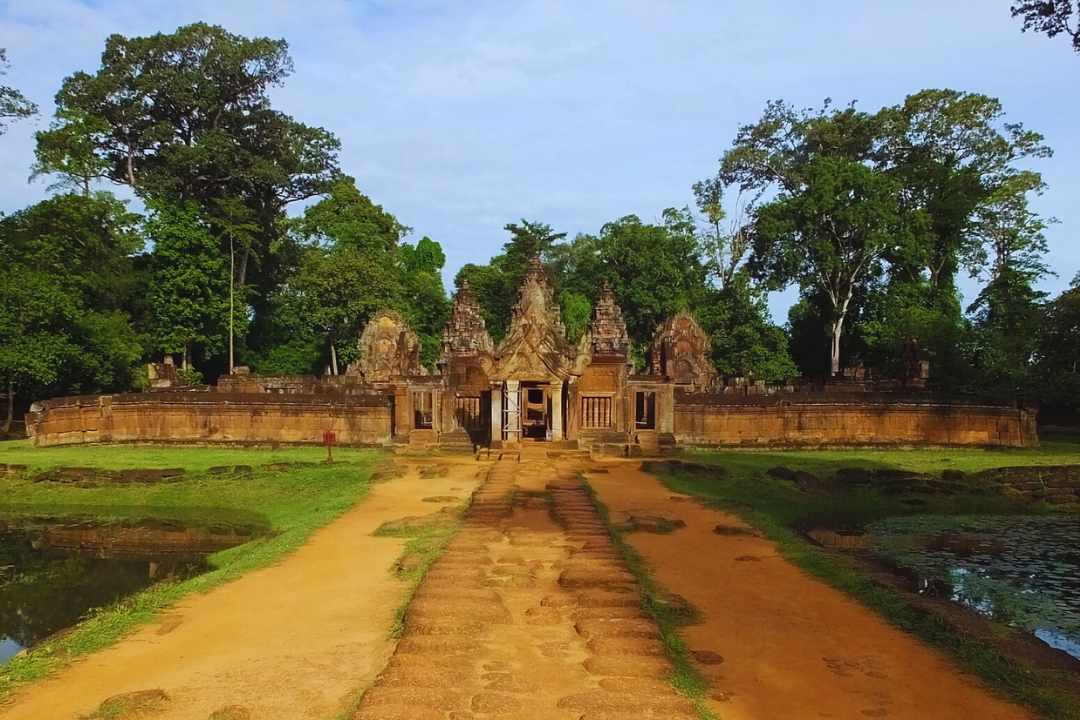Hidden in Plain Sight – Angkorian Architecture’s Surprising Global Impact
October 9, 2024

Table of Contents
Hidden in Plain Sight – Angkorian Architecture’s Surprising Global Impact
Did you know Angkor Wat is the biggest old building before the 1900s? It’s huge, measuring 215 meters by 186 meters. It even goes up over 60 meters high. I’m always amazed by its huge size.
Exploring this temple complex is amazing. New scans have shown a big city around Angkor Wat. It covers about 1,000 square kilometers. This changes how we see its big impact.
The Khmer empire’s mark goes beyond the temple. Greater Angkor, around Angkor Wat, had about 750,000 people. It’s hard to imagine such a big city long ago.
Key Takeaways
- Angkor Wat is the largest pre-20th-century religious building globally
- The temple complex spans 215m by 186m and rises over 60m
- Greater Angkor covered an estimated 1,000 square kilometers
- The urban complex housed around 750,000 inhabitants
- LiDAR scans have revealed hidden structures and canals
- Angkor Wat’s landscape is more complex than previously thought
2-Day Angkor Wat Sunrise & Banteay Srei Grand Tour – Small Group Tours
The Majestic Legacy of Angkor Wat
I’m always amazed by Angkor Wat. This temple complex is a wonder of Khmer civilization. Built in the early 12th century, it’s a Hindu architecture marvel that draws visitors worldwide.
A Testament to Khmer Ingenuity
Angkor Wat’s construction shows the Khmer people’s advanced engineering. The temple’s design uses sandstone blocks from quarries over 50 kilometers away. These huge stones fit together with mortise and tenon joints, lasting centuries.
Suryavarman II’s Architectural Marvel
King Suryavarman II built this grand temple as a state temple and capital. The design reflects Hindu cosmology, with a central tower like Mount Meru. It took about 30 years to complete, showing the huge effort put into it.
The World’s Largest Pre-20th Century Religious Building
Angkor Wat’s size is amazing. Its central tower is 65 meters tall, and the complex has a 1.5 by 1.3 kilometer moat. The temple’s bas-reliefs, covering 1,200 square meters, tell stories of Hindu epics and Khmer history.
| Feature | Measurement |
|---|---|
| Total Area | Over 400 acres |
| Central Tower Height | 65 meters (213 feet) |
| Moat Dimensions | 1.5 km x 1.3 km |
| Bas-Relief Area | 1,200 square meters |
| Construction Time | Approximately 30 years |
Unveiling the Secrets of Greater Angkor
I’ve always been amazed by the new finds in Greater Angkor. This huge area, covering 1,000km2, is even bigger than the Classic Maya centers. Projects using remote sensing have shown us a hidden world under the jungle.
Christophe Pottier, Roland Fletcher, and Damian Evans have made big discoveries. Their research is changing how we see Angkor’s landscape. They found a complex network of old roads, canals, and buildings.
Here’s a glimpse of what they’ve found:
- Extensive canal systems
- Ancient roadways
- Countless ponds
- Remnants of housemounds
- Hidden shrines
- Vast rice fields
These discoveries change what we thought about Angkor. It was more than just temples. It was a big city with hundreds of thousands of people.
| Feature | Discovery Impact |
|---|---|
| Canals | Revealed complex water management |
| Roads | Showed extensive urban planning |
| Housemounds | Indicated dense population centers |
| Rice fields | Suggested large-scale agriculture |
These finds show Greater Angkor was a smart city, much more advanced than we thought. Remote sensing helped uncover these secrets, hidden for years under the jungle.
Angkorian Architecture: A Celestial Blueprint on Earth
I love how ancient buildings mix sacred design with the stars. Angkor Wat is a great example. It shows Hindu beliefs in its layout. The main tower is like Mount Meru, a sacred mountain.
Cosmic Mountains and Heavenly Seas
The temple looks like the universe. Its five domes are like Mount Meru’s peaks. The big moat around it is like the cosmic ocean. It’s huge, covering over 400 acres.
Divine Rulers and Celestial Communication
Angkor Wat was a special place for Khmer kings. It has 73 special lines that match the sun’s path. This helped kings talk to gods and their ancestors.
The Symbolism of Angkor Wat’s Design
The temple’s design is full of meaning. It looks like a lotus bud, important in Hindu and Buddhist beliefs. Over 2,000 Apsaras, or celestial dancers, decorate the walls. They show the best of Khmer art and beliefs.
| Feature | Symbolism | Measurements |
|---|---|---|
| Central Tower | Mount Meru | 213 feet high |
| Five Domes | Peaks of Mount Meru | Varying heights |
| Surrounding Moat | Cosmic Ocean | 3.4 miles perimeter |
| Temple Area | Miniature Universe | Over 400 acres |
2-Day Lost City of Koh Ker, Beng Mealea & Floating villages Tour – Small Group Tours
The Workforce Behind the Wonder
I’m always amazed by the sheer scale of ancient engineering projects. Angkor Wat’s construction is a prime example. It took 37 years to complete, with 50,000 workers working day and night.
The ancient Khmer empire needed food surpluses for such a big project. Rice from nearby regions and fish from Tonle Sap lake helped. These resources fed thousands of people, including those working on the temples.
Let’s break down the numbers:
- 4,500 people lived within Angkor Wat’s moated boundary
- 25,000 workers were directly involved in the temple’s construction and maintenance
- 125,000 additional people supplied goods and services to support the project
This huge workforce shows the complex systems of Angkor. The empire’s rice and fish surpluses fed nearly 1 million people. This made Greater Angkor one of the biggest cities before the industrial age.
The scale of this ancient engineering marvel still inspires awe. It shows the Khmer workforce’s ingenuity and organization.
Bas-Reliefs: A Stone Canvas of Khmer Life
I’m always amazed by the intricate bas-reliefs at Angkor Wat. These stone carvings show us ancient Khmer life. They tell us about their culture and beliefs.
The red sandstone walls come alive with scenes. These include Hindu mythology, daily life, and historic events.
Suryavarman’s Court in Stone
One of the most striking bas-reliefs shows King Suryavarman II on his throne. The detail is incredible. From the king’s regal pose to the courtiers around him, it’s like stepping back in time.
Battle Scenes and Celestial Maidens
The walls of Angkor Wat are filled with dynamic battle scenes and graceful apsaras, or celestial dancers. These carvings bring Khmer art to life. They show the skill of ancient artisans.
I can almost hear the clash of weapons and the tinkling of dancers’ bells when I look at these scenes.
Unfinished Masterpieces
Interestingly, some sections of the bas-reliefs remain unfinished. These incomplete carvings offer a unique glimpse into the construction process of Angkor Wat. It’s fascinating to see the different stages of work.
| Bas-Relief Theme | Description | Significance |
|---|---|---|
| Religious Stories | Scenes from Hindu epics | Reflects Khmer spiritual beliefs |
| Historical Events | Depictions of battles and royal life | Preserves Khmer history |
| Daily Life | Scenes of common activities | Provides insight into Khmer society |
These bas-reliefs are more than just beautiful art. They’re a priceless record of Khmer culture, religion, and social structure. Every time I visit, I discover something new in this stone canvas of ancient life.
The Temple-City Myth: Rewriting Angkor’s Urban Landscape
I’ve always been amazed by new discoveries in Angkorian capitals. The old idea of Angkor Wat as a crowded “temple-city” is changing. Now, we see it as a big, open urban area, not a series of small cities.
This new view is changing how we see Angkorian cities. It makes us think differently about how people lived and how temples fit into their surroundings. The complexity of Angkor’s city layout is incredible.
| Traditional View | New Perspective |
|---|---|
| Densely populated “temple-city” | Vast, low-density urban complex |
| Successive small, walled capitals | Extensive urban landscape |
| Temples as isolated structures | Temples integrated into wider urban context |
Angkorian cities were more advanced than we thought. Angkor Wat is the biggest religious building in the world. It was added to the World Heritage List in 1992. Building it moved 7.5 million tonnes of stone and earth, as much as the Great Pyramid of Khufu in Egypt.
This new knowledge shows we need to keep studying Angkorian cities. It’s thrilling to think about what we might learn next about these ancient Khmer cities.
LiDAR Technology: Peeling Back the Jungle Veil
LiDAR technology has changed how we explore Angkor Wat. It shows us hidden structures and landscapes that were hidden for years. The jungle can’t hide these secrets from LiDAR’s powerful lasers.
Revealing Hidden Structures
Since 2007, we’ve learned Angkor Wat was huge, like modern Berlin. LiDAR has shown us a city with roads, canals, and buildings. These were hidden before.
The Eastern Extension: Administrative Hub or Residential Area?
A big eastern part of Angkor Wat is fascinating. It might have been for government or homes. The buildings show it was a busy place, bigger than we thought.
Mysterious Rectilinear Spirals: Gardens or Raised Fields?
LiDAR found special spiral shapes south of the moat. They might be gardens or fields. They show smart land use and add to our knowledge of Angkor Wat.
Beyond the Walls: Angkor Wat’s Wider Context
Angkor Wat is just one part of a big picture. It’s part of Greater Angkor, a huge area that shows the Khmer’s skill in building and planning. This area is about 400 acres, making it the biggest religious site in the world.
The Khmer people were very smart. They built a network of canals, reservoirs, and irrigation systems. This helped their farms grow and their cities thrive.
Their city planning was amazing. They arranged temples, homes, and public areas in a special way. This made their city a peaceful place to live.
| Feature | Description | Significance |
|---|---|---|
| Greater Angkor | Extensive urban network | Showcases advanced Khmer civilization |
| Hydraulic Engineering | Complex water management system | Supported agriculture and urban life |
| Khmer Urbanism | Thoughtful city layout | Balanced religious, residential, and public spaces |
Seeing Angkor Wat in a bigger picture shows the Khmer’s true genius. They didn’t just build temples. They created a society that was both spiritual and practical.
Global Influence: Angkor Wat as a Living Archive
Angkor Wat’s impact goes beyond its walls. It’s a symbol of cultural exchange and religious mix. Every year, 2.5 million people visit, making it a key topic in studies.
From Hindu Temple to Buddhist Pilgrimage Site
Angkor Wat started as a Hindu temple in 1150 CE. King Suryavarman II built it for Vishnu. Later, it became a Buddhist temple, showing the area’s religious changes.
Multilingual Messages: A Testament to Global Visitors
The temple’s walls show a story of world travelers. They found messages in many languages like Burmese and Chinese. This shows Angkor Wat as a place where cultures meet.
Cultural Imprints: Statues, Inscriptions, and Wall Art
Visitors left their mark in many ways. Statues and wall art tell stories of history. Despite theft, Cambodia has recovered many items. Angkor Wat is now a symbol of strength, on the Cambodian flag, and still fascinates the world.
Recent Post
Get 30% Discount Now
Categories
Guided Tours

Private Siem Reap Airport SAI Transfers – Siem Reap Airport Pick-up or Drop-off, Just for You!
From: 30$
Shared SAI Siem Reap Airport Transfer – We depart every 1 hour!
From: 9$
Private Full-Day Siem Reap to Koh Ker & Beng Mealea Temple Tour
From: 75$
2-Day Angkor Wat Sunrise & Banteay Srei Grand Tour – Small Group Tours
From: 30$
2-Day Angkor Wat Temple Sunset and Floating Village Tour
From: 40$
3-Day Angkor Wat Sunrise, Banteay Srei and Floating Villages Tour – Small Group Tours
From: 50$